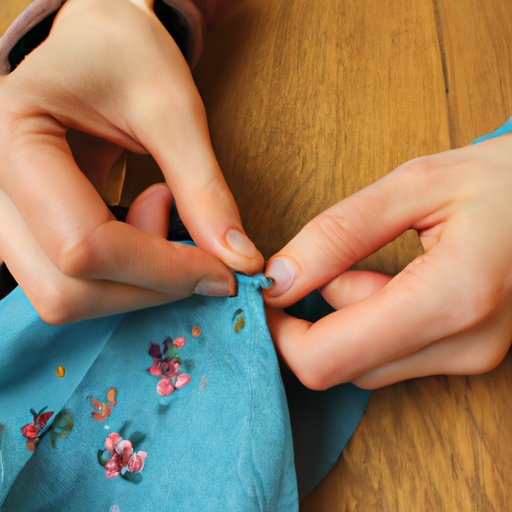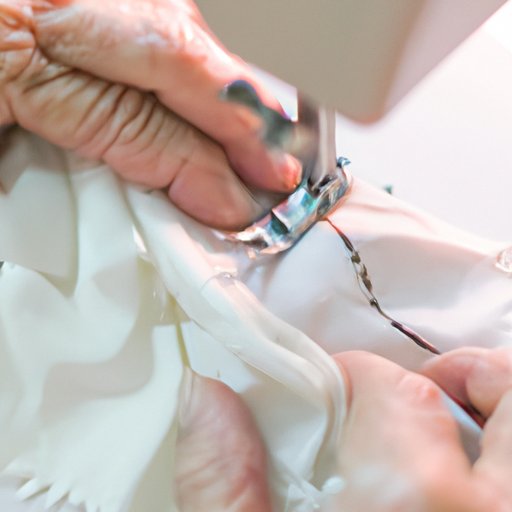
Introduction
Hand sewing is an essential skill to learn for anyone interested in crafting, DIY projects, or fashion design. Regardless of your sewing experience, having the ability to sew by hand allows for more creative freedom, and it can save you money on costly alterations or repairs. In this article, we’ll explore the basics of hand sewing, tips and tricks for successful projects, and more advanced techniques for sewing enthusiasts.
Tips and Tricks for a Successful Hand Sewing Project
Before beginning any hand sewing project, it’s essential to have the proper tools. A good-quality needle, thread, fabric, and a pair of scissors are the basics. However, there are other optional tools that you may also wish to have on hand to make the process more comfortable and efficient.
Once you have all the necessary supplies, it’s time to practice proper hand sewing technique. It’s important to use a thimble on the finger you are using to push the needle through the fabric; this will protect your skin from being poked. Additionally, try to avoid tying knots in the thread when you start or finish your sewing; instead, bury the thread inside the fabric for a more seamless look.
Finally, when hand sewing, always maintain proper posture. Sit comfortably at a table or desk and keep your shoulders relaxed. Do not hunch over or strain your eyes when sewing; this can cause discomfort and tension.
From choosing the right thread to creating a flawless finish
Choosing the right thread and needle is just as important as using proper technique when handsewing. When selecting thread, choose a weight appropriate for the type of fabric you are working with. Using a heavier weight thread on a lightweight fabric can ruin the final result.
When selecting a needle, consider the type of fabric you are working with, and the type of stitches you plan to use. Generally, finer fabrics require a finer needle.
To achieve a neat and clean finish, use a combination of backstitch and whipstitch. The backstitch is great for seams that need to be sturdy, such as those on pants or shirts. The whipstitch is an excellent way to hem skirts, or finish the edges of your fabric.

How to Mend and Alter Clothing by Hand
Knowing how to mend and alter clothing by hand is an essential skill for anyone wanting to save money on alterations or repairs. Learn how to fix holes and tears in clothing, hem your pants, and alter clothes that no longer fit.
The first step in mending is to assess the damage and decide how to fix it. For small holes or tears, use a simple whipstitch to repair the fabric. For more significant repairs, such as a large tear, it might be necessary to patch the fabric first.
Hemming pants by hand is a straightforward process. Measure the length of the desired hem and use a marking tool to mark the fabric. Pin the hem in place and stitch it together using a whipstitch or an invisible stitch. Altering clothing that no longer fits can also be done by hand, and it’s a great way to save money on alterations.
Simple Embroidery Stitches Every Sewer Should Know
Embroidery is a beautiful way to add character and a personalized touch to your sewing projects. There are various types of embroidery stitches, so choose the ones you feel comfortable with and incorporate them into your designs.
Some beginner-friendly embroidery stitches include the chain stitch, cross stitch, and French knot. Once you have learned the basics, experiment with different stitches and designs to create unique and personalized embroidery pieces.
Sewing by Hand: The Eco-Friendly Alternative
Sewing by hand is an environmentally friendly alternative to using a machine. It saves energy and reduces carbon footprint while producing less waste. Additionally, hand sewing enables you to use eco-friendly fabrics that are not suitable for machine sewing, such as water-repellent cotton and organic linen.
On top of environmental benefits, hand sewing is also cost-effective. A sewing machine can be costly, and the electricity it requires can be expensive. Hand sewing requires only a few essential tools and can save money in the long run.
The Art of Quilting by Hand
The art of quilting by hand has a long history that dates back to ancient Egypt and Rome. Today, quilting remains a popular hobby, with many quilters preferring to do it by hand instead of by machine.
Quilting by hand adds a unique touch and a sense of personalization to your quilting project. It requires patience and attention to detail but produces beautiful results. There are various quilting techniques and styles, from traditional log cabin to modern improvisational quilting.
Sewing for the Sake of Relaxation and Creativity
In addition to being a practical skill, sewing by hand can also provide a sense of relaxation and creativity. Hand sewing requires slow and deliberate movements, allowing you to focus on the present moment and forget about the stresses of daily life.
Studies have shown that sewing can improve mental health by reducing stress, anxiety, and depression. Additionally, it provides a sense of accomplishment, which can boost self-confidence and overall well-being.
Conclusion
In conclusion, hand sewing is an essential skill to learn for anyone interested in DIY, crafting, or fashion design. With the proper tools, technique, and practice, you can create beautiful and personalized sewing projects. From mending clothing to quilting by hand, the possibilities are endless. We hope this article inspires you to try hand sewing yourself and discover the many benefits it has to offer.




